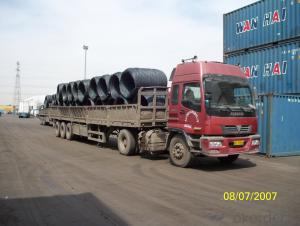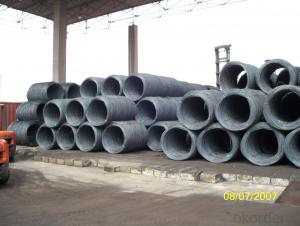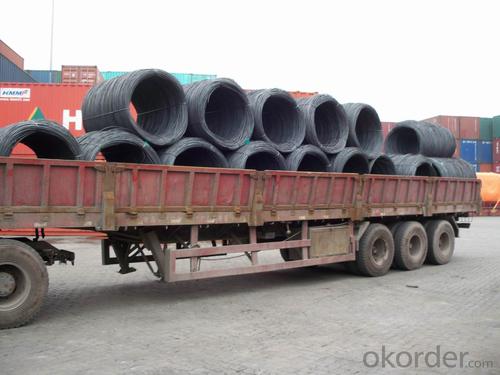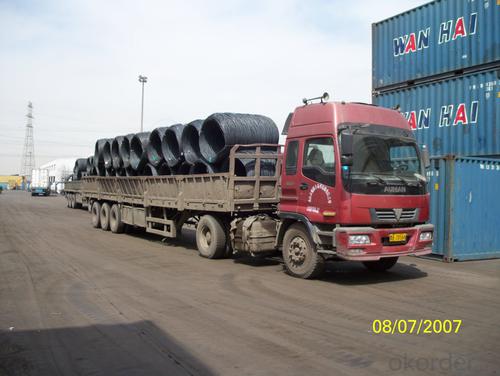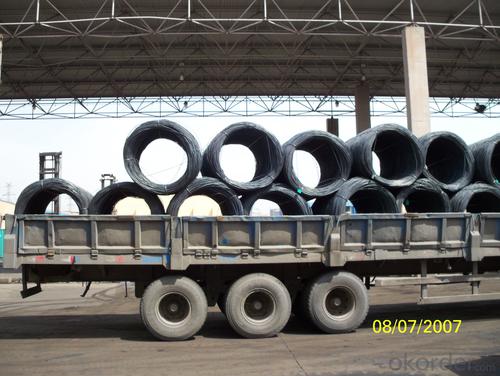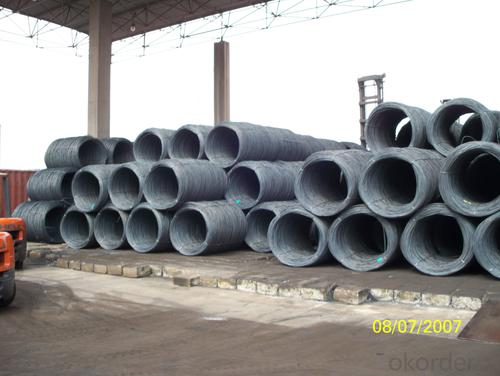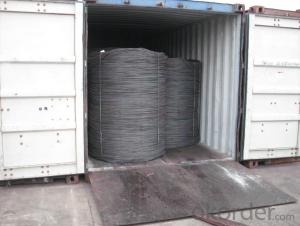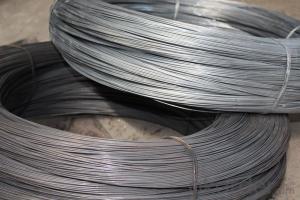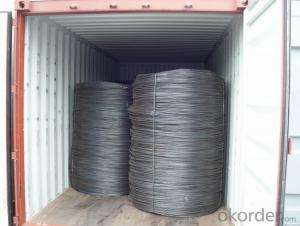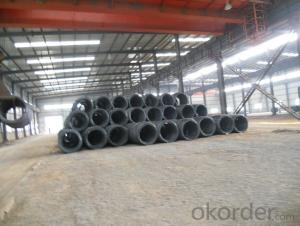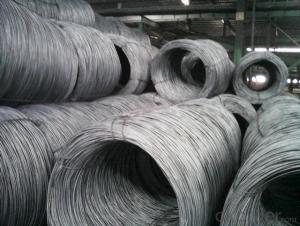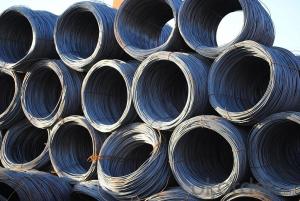SAE1006Cr Carbon Steel Wire Rod 8.5mm for Welding
- Loading Port:
- Shanghai
- Payment Terms:
- TT OR LC
- Min Order Qty:
- 100 m.t
- Supply Capability:
- 30000 m.t/month
OKorder Service Pledge
OKorder Financial Service
You Might Also Like
Specification
Description of SAE1006Cr Carbon Steel Wire Rod 8.5mm for Welding:
OKorder is offering Color Coated Steel Coil Prepainted Steel Coil at great prices with worldwide shipping. Our supplier is a world-class manufacturer of steel, with our products utilized the world over. OKorder annually supplies products to European, North American and Asian markets. We provide quotations within 24 hours of receiving an inquiry and guarantee competitive prices.
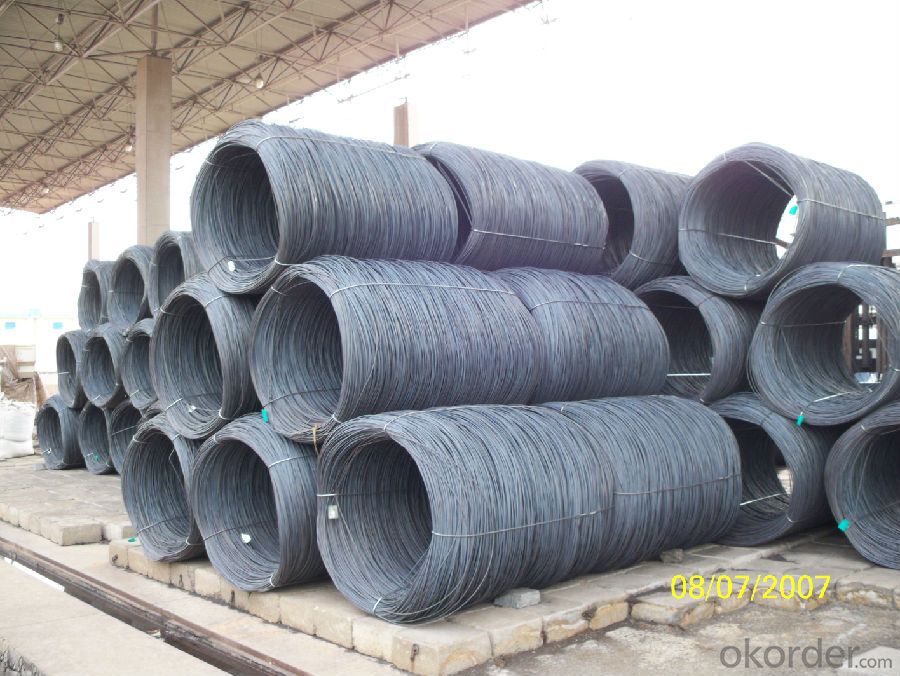
Applications of SAE1006Cr Carbon Steel Wire Rod 8.5mm for Welding:
Color Coated Steel Coil Prepainted Steel Coil are ideal for structural applications and are widely used in the construction of buildings and bridges, and the manufacturing, petrochemical, and transportation industries.
Main Product Features of SAE1006Cr Carbon Steel Wire Rod 8.5mm for Welding:
· Premium quality
· Prompt delivery & seaworthy packing (30 days after receiving deposit)
· Corrosion resistance
· Can be recycled and reused
· Mill test certification
· Professional Service
· Competitive pricing
Specifications of SAE1006Cr Carbon Steel Wire Rod 8.5mm for Welding:
PPGI:
1, Introduction: Color coated steel coils(sheets), i. E. PPGI, also called prepainted steel coils(sheets), are made of galvanized steel coils(sheets) with polymer coatings as surface. It's a new enclosure material and building board with characteristics of light-weighted, heat preserved&insulated, easily installed with bright colors.
2, Production Process: Pretreatment(Degreasing)_Drying_Chromating_Paint Basic Oil_Cooling_Drying_Color Coating_Cooling_Film-covering_Rolling Up
3, Characteristics:
Good at corrosion resistence. Besides zinc coating of the basic plate of galvanized steel sheet, the color coating as the surface has double lifetime to ensure better anticorrosion effect.
With excellent cold bending molded manufacturablity, PPGI products can be processed or directly used as final product. As being light-weighted and conveniently transported, they're widly used to replace wood to save energy.
4.There're thousands of colors can be chosen as per different application. Any color plays well in decoration.
No pollution with high recycling rate, PPGI coils and sheets are strongly recommended as enviroment-friendly products by the government.
5, eye bands and 4 circumferential bands in steel, galvanized metal fluted rings on inner and outer edges, galvanized.
| commodity | SAE1006Cr Carbon Steel Wire Rod 8.5mm for Welding |
| Techinical Standard: | JIS G3302-1998, EN10142/10137, ASTM A755 |
| grade | Q195,Q215,Q235,SAE1006,SAE1008 SAE1006Cr |
| Types: | Mesh welding |
| Base metal | galvanized, galvalume, cold rolled steel |
| Thickness | 0.14-1.0mm(0.16-0.8mm is the most advantage thickness) |
| Width | 610/724/820/914/1000/1200/1219/1220/1250mm |
| Type of coating: | PE, SMP, PVDF |
| Zinc coating | Z60-150g/m2 or AZ40-100g/m2 |
| Top painting: | 5 mic. Primer + 15 mc. R. M. P. |
| Back painting: | 5-7 mic. EP |
| Color: | According to RAL standard |
| ID coil | 508mm610mm |
| Coil weight: | 2--3MT |
| Package: | Properly packed for ocean freight exportation in 20'containers |
| Application: | Industrial panels, roofing and siding for painting/automobile |
| Price terms | FOB, CFR, CIF |
| Payment terms | 20%TT in advance+80% TT or irrevocable 80%L/C at sight |
| delivery time | 25 days after recepit of 20% TT |
| Remarks | Insurance is all risks |
| MTC 3.1 will be handed on with shipping documents | |
| We accept SGS certificatation test |
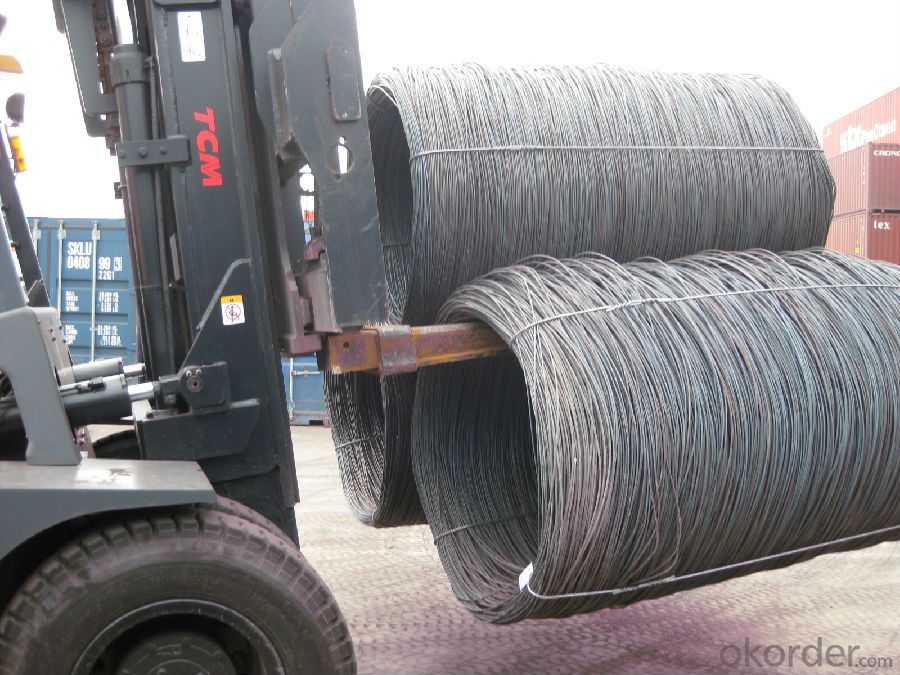
FAQ of SAE1006Cr Carbon Steel Wire Rod 8.5mm for Welding:
Q1: Why buy Materials & Equipment from OKorder.com?
A1: All products offered byOKorder.com are carefully selected from China's most reliable manufacturing enterprises. Through its ISO certifications, OKorder.com adheres to the highest standards and a commitment to supply chain safety and customer satisfaction.
Q2: How do we guarantee the quality of our products?
A2: We have established an advanced quality management system which conducts strict quality tests at every step, from raw materials to the final product. At the same time, we provide extensive follow-up service assurances as required.
Q3: How soon can we receive the product after purchase?
A3: Within three days of placing an order, we will begin production. The specific shipping date is dependent upon international and government factors, but is typically 7 to 10 workdays.
Q4: What makes stainless steel stainless?
A4: Stainless steel must contain at least 10.5 % chromium. It is this element that reacts with the oxygen in the air to form a complex chrome-oxide surface layer that is invisible but strong enough to prevent further oxygen from "staining" (rusting) the surface. Higher levels of chromium and the addition of other alloying elements such as nickel and molybdenum enhance this surface layer and improve the corrosion resistance of the stainless material.
Q5: Can stainless steel rust?
A5: Stainless does not "rust" as you think of regular steel rusting with a red oxide on the surface that flakes off. If you see red rust it is probably due to some iron particles that have contaminated the surface of the stainless steel and it is these iron particles that are rusting. Look at the source of the rusting and see if you can remove it from the surface.
- Q: How is steel wire rod used in the production of wire mesh for sieving?
- Steel wire rod is a crucial component in the production of wire mesh for sieving. The wire rod is first processed through a series of manufacturing steps to transform it into a suitable material for wire mesh production. This includes drawing the rod through a die to reduce its diameter and increase its length, resulting in a thin and elongated wire. Once the wire rod has been transformed into wire, it is then woven or welded together to create wire mesh. Wire mesh is a grid-like structure with evenly spaced intersecting wires, forming a pattern of uniform openings. This mesh is designed to efficiently filter and separate particles based on their size. In the production of wire mesh for sieving, the steel wire rod is typically used to create the woven wire mesh. The wire is woven together using various weaving techniques, such as plain weave, twill weave, or Dutch weave, depending on the desired mesh characteristics. The wire rod's properties, such as its strength, flexibility, and resistance to corrosion, play a vital role in the quality and durability of the wire mesh. The wire rod's strength ensures that the wire mesh can withstand the tension and stress it may encounter during sieving operations. Additionally, the flexibility of the wire allows the mesh to be easily shaped and manipulated into various sizes and configurations to meet specific sieving requirements. Furthermore, the steel wire rod's resistance to corrosion prevents the wire mesh from deteriorating when exposed to moisture or harsh environmental conditions. This corrosion resistance is particularly important when wire mesh is used in applications where it comes into contact with liquids or substances that could potentially cause damage. Overall, the steel wire rod is an essential material in the production of wire mesh for sieving. Its transformation into wire and subsequent weaving or welding processes enable the creation of durable, reliable, and efficient wire mesh, which is widely used in various industries for sieving and separating particles of different sizes.
- Q: What are the standard bending requirements for steel wire rod?
- The standard bending requirements for steel wire rod depend on the specific application and industry standards. However, some common bending requirements for steel wire rod include achieving a specific radius or angle without causing cracking, breaking, or excessive deformation of the material. These requirements are often specified in terms of minimum bend radii, maximum bend angles, and acceptable levels of distortion or elongation. It is important to consult the relevant industry standards and guidelines to ensure compliance with the specific bending requirements for steel wire rod.
- Q: How is steel wire rod used in the manufacturing of wire for 3D printing?
- Steel wire rod is an essential component in the manufacturing process of wire for 3D printing. It serves as the raw material for producing high-quality wire that is used in various applications within the 3D printing industry. To begin with, steel wire rod is first subjected to a series of rigorous quality control checks to ensure its suitability for the manufacturing process. These checks involve examining the chemical composition, mechanical properties, and surface condition of the rod. Once the rod passes these tests, it is considered suitable for further processing. The steel wire rod is then fed into a wire drawing machine, where it undergoes a process called wire drawing. In this process, the rod is pulled through a series of dies with progressively smaller diameters, resulting in the reduction of its diameter and an increase in its length. This process helps in improving the wire's surface finish and dimensional accuracy. After wire drawing, the steel wire is further processed to remove any surface impurities or contaminants. This is done through a process called pickling, where the wire is immersed in an acid solution to dissolve any oxides or scales that may have formed during the wire drawing process. This ensures that the wire is clean and ready for subsequent manufacturing steps. The final step in manufacturing wire for 3D printing involves coating the steel wire with a layer of polymer or metal alloy. This coating serves multiple purposes, such as improving the wire's adhesion to the printing bed, enhancing its durability, and providing a smooth surface finish to the 3D printed object. Overall, steel wire rod plays a crucial role in the manufacturing of wire for 3D printing. Its high tensile strength, excellent mechanical properties, and ability to withstand high temperatures make it an ideal choice for producing wire that meets the demanding requirements of the 3D printing industry.
- Q: What are the disadvantages of using steel wire rods in construction?
- Using steel wire rods in construction has a few drawbacks: 1. Corrosion is a concern, particularly in humid and coastal areas. Steel is prone to rusting when exposed to moisture and oxygen, leading to structural weakness and deterioration. This compromises the project's integrity and increases maintenance costs. 2. Weight is another issue. Steel wire rods are heavy, making transportation and installation more difficult. The added weight can stress the foundation and supporting structures, potentially causing long-term structural problems. 3. Limited flexibility is a drawback compared to materials like concrete or timber. Steel wire rods are not as adaptable to complex architectural designs or unique construction requirements. 4. Cost is a consideration. Steel wire rods can be expensive, especially if high-quality materials are needed. The expenses of transportation, installation, and maintenance can also add up, making it less cost-effective for certain projects. 5. Thermal conductivity is high in steel, meaning it transfers heat quickly. This can result in increased energy consumption and higher heating or cooling costs for buildings made with steel wire rods. 6. Environmental impact is a significant concern. Steel production is resource-intensive and has a substantial environmental footprint. The extraction and manufacturing processes emit greenhouse gases and contribute to pollution. Additionally, disposing of steel wire rods at the end of their lifespan poses environmental challenges. In conclusion, while steel wire rods offer many advantages in construction, it is crucial to consider these disadvantages and explore alternative materials based on project requirements, environmental considerations, and budget limitations.
- Q: What is the size range of steel wire rod?
- The size range of steel wire rod can vary, but it is typically between 5.5mm to 20mm in diameter.
- Q: How is steel wire rod recycled at the end of its lifecycle?
- Steel wire rod can undergo steel scrap recycling at the end of its lifecycle. This involves a number of steps to transform the wire rod into reusable steel materials. To begin the recycling process, steel wire rod scraps are collected from various sources such as manufacturing waste, construction materials, or end-of-life products like old cars or appliances. Once collected, the scraps are sorted and separated based on their composition and quality. The sorted steel wire rod scraps are then sent to a recycling facility where they are shredded into smaller pieces to facilitate further processing. Shredding can be done using different methods, such as hydraulic shears or industrial shredders. After shredding, the steel wire rod pieces undergo magnetic separation to remove any non-ferrous materials like plastic or rubber that may be mixed with the scraps. Magnetic separators attract and remove these non-ferrous materials, leaving behind the steel wire rod pieces. The separated steel wire rod pieces are further processed to remove impurities or contaminants. This is done through a process called melting, where the wire rod pieces are heated to extremely high temperatures in a furnace. This melting process burns off or skims off any impurities or contaminants from the molten metal. Once the impurities are removed, the molten steel is poured into molds to form new steel products. The molds can vary depending on the desired shape and size of the final product. After the steel has solidified, it can be further processed and treated to meet specific requirements, such as tempering or strengthening. The recycled steel wire rod can be used as raw material in industries like construction, automotive manufacturing, and appliance production. This reduces the need for extracting and refining virgin iron ore, which conserves natural resources and minimizes environmental impact. In conclusion, steel wire rod is recycled through a series of steps including collection, sorting, shredding, magnetic separation, melting, molding, and further processing. This process allows the steel to be reused in various industries, promoting sustainability and reducing the demand for new steel production.
- Q: How is steel wire rod stored to prevent corrosion?
- Steel wire rods are typically stored in a way that minimizes the risk of corrosion. One common method is to store the rods in a well-ventilated area with controlled humidity levels. This helps to prevent the build-up of moisture, which can accelerate the corrosion process. Another preventive measure is to store the steel wire rods in a dry environment and off the ground. This can be achieved by placing the rods on pallets or racks, ensuring that they are not in direct contact with the floor. By keeping the rods elevated, any potential moisture or water accumulation on the ground is avoided. Furthermore, steel wire rods can be stored indoors in a climate-controlled warehouse. Maintaining a stable temperature and humidity level can significantly reduce the chances of corrosion. These controlled environments help to minimize moisture exposure and prevent the formation of rust on the wire rods. In addition to these storage practices, coating the steel wire rods with a protective layer is also a common preventive measure. This can be done by applying a corrosion-resistant coating such as zinc or epoxy. The coating acts as a barrier between the rods and the surrounding environment, preventing moisture from reaching the surface of the wire rods and causing corrosion. Overall, proper storage of steel wire rods involves minimizing moisture exposure, maintaining controlled humidity levels, keeping the rods off the ground, and using protective coatings. By implementing these measures, the risk of corrosion is significantly reduced, ensuring that the steel wire rods remain in optimal condition until they are ready for use.
- Q: What are the common industry competencies for steel wire rod suppliers?
- Some common industry competencies for steel wire rod suppliers include expertise in steel production and manufacturing processes, knowledge of industry standards and regulations, ability to meet quality and performance requirements, strong supply chain management skills, excellent customer service, and a track record of delivering products on time. Additionally, suppliers should have a strong understanding of market trends and the ability to adapt to changing customer needs.
- Q: What are the national standards for steel wire rod?
- The national standards for steel wire rod vary from country to country, as each country has its own set of regulations and requirements for the production and quality control of steel wire rod. These standards typically cover aspects such as chemical composition, mechanical properties, dimensions, tolerance levels, testing methods, and packaging. It is important for manufacturers and suppliers to adhere to these national standards to ensure the safety and reliability of steel wire rod products in their respective markets.
- Q: What are the main factors affecting the market mergers of steel wire rod?
- The main factors affecting the market mergers of steel wire rod include the level of competition in the industry, regulatory environment, economic conditions, technological advancements, and the overall demand for steel wire rod. Additionally, factors such as production capacity, market share, and cost efficiencies also play a significant role in shaping the market mergers of steel wire rod.
Send your message to us
SAE1006Cr Carbon Steel Wire Rod 8.5mm for Welding
- Loading Port:
- Shanghai
- Payment Terms:
- TT OR LC
- Min Order Qty:
- 100 m.t
- Supply Capability:
- 30000 m.t/month
OKorder Service Pledge
OKorder Financial Service
Similar products
Hot products
Hot Searches
Related keywords

